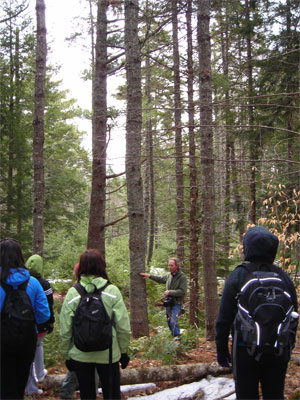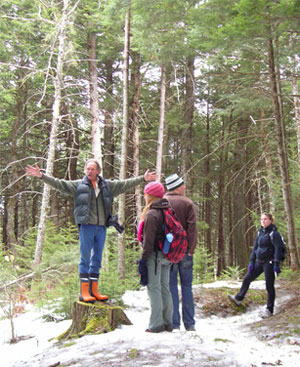 |
| Jeff Amos points out the growth characteristics of trees. (Danielle Horne Photo) |
The campus was quiet on this early, sunny Saturday morning. A few of us students gathered, geared up to explore the forest and see how one man is making a living from sustainable forestry.
The hike was organized by the Ecology Action Centre, with funding from Mountain Equipment Coop. We travelled out of the city, past the shops and farms to a little town on the south shore called Blockhouse, where this story begins.
This town is home to Jeff Amos, woodworker, photographer and sustainable forester. While studying ecology at the Carleton University in Ottawa, Mr. Amos, like many students, worked hard in the summer months as a logger for a company in British Columbia to pay for his secondary education and this is how he first came into the forestry industry. He thinks it ironic that he “slaughtered one to go to the utopia of another.”
As we stand outside his company building, Mr. Amos talks about the absolute foolishness of growing apples in the Annapolis Valley and shipping them to Ontario, then shipping apples grown in Ontario to Nova Scotia: it increases travel costs, increases car emissions, and takes money away from our local people. His main supplier is Travis Parsons who owns an 8,000 acre woodlot very close to Jeff’s company, Logs to Lumber, and his own woodlot is connected to his sawmill through an old railway track on which the horses will be able to transport the logs.
 |
| Blockhouse resident Jeff Amos talks about the disturbance pattern in the Acadian forest: how one tree falling can cause the light to change dramatically. (Danielle Horne Photo) |
We hop on the bus for a short jaunt down the road to the woodlot. As we disembark, Mr. Amos remarks, “you’ll be astonished by the stories that are told over here, over here and over here” as he points to different areas. He shows us an aerial map of his property and explains that “this patch of land has 32 stories…while humans may have many chapters within a story; a forest has many stories with many chapters.” He calls these lands of his “strong lands”—a phrase learned from an older woman—which means they are able to sustain a family.
As we walk through the forest, Mr Amos takes the time to point out and explain why he would pick a certain tree to come down. He points out one that has scarring about six metres up and its crown is not looking well. Another is growing too close to a neighbour of higher economical value. These are the trees that will soon be harvested.
Woodlot owners like Mr. Amos are striving to manage their woodlots while rebuilding the Acadian Forest, a natural mix of hardwoods and softwoods made up of trees of all ages. The Acadian Forest Region is unique to the Maritimes, extending slightly into the United States. The FSC (Forest Stewardship Council) was established in 1993 and provides solid guidelines for truly sustainable forests, but Travis Parsons wants “to be better than the best,” and so Mr. Amos is also aiming to be better than the best too.
I’d like to take a moment to thank Mountain Equipment Co-op, Coastal Woodlands & Tree Services, and the woodlot owners Jeff Amos, Bob Bancroft and Alice Reed, and Kevin Veinotte for their time and guidance.
Through an internship at the Ecology Action Centre, Danielle Horne has been working to organize a series of hikes around Nova Scotia with various groups. This is her last year at Dalhousie, where she will graduate with a Major in Biology and a Minor in Environmental Studies and go on to apply all the knowledge she has learned to solve new and exciting challenges.
